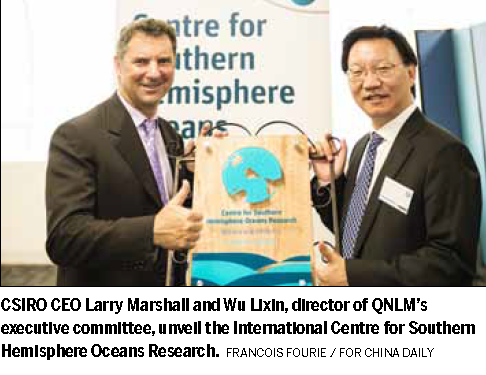Centre helps research into southern oceans
By Zhang Zhao ( China Daily )
Updated: 2017-11-29
|
|||||||||
The Qingdao National Laboratory for Marine Science and Technology, or QNLM, is building a global marine innovation network by expanding international cooperation.
QNLM and the Australian Commonwealth Scientific and Industrial Research Organization launched the International Centre for Southern Hemisphere Oceans Research in late May in Hobart, Tasmania.
As an important part of the global climate system, oceans cover 71 percent of the planet's area and absorb 40 percent of carbon dioxide in the atmosphere.
Scientists around the world have dedicated themselves to studying how oceans affect global climate change. However, while most marine research institutions and marine data are based in the northern hemisphere, it is only in the southern hemisphere that oceans are not separated by continents, and thus span the globe uninterrupted.
Therefore, the international community has been making great effort in recent years to strengthen research capacity for the southern hemisphere oceans.
The International Centre for Southern Hemisphere Oceans Research plans to invest A$10 million (£6.2 million) over the next five years in observing and researching the southern hemisphere's oceans, as well as in education, training and management of information and data.
The centre is internationally operated, with its key issues decided by a five-member steering committee. Two members are from the QNLM and two are from the CSIRO, under the lead of Susan Avery, honorary director of Woods Hole Oceanographic Institution in the United States. The director of the centre is globally recruited and responsible for its routine operation.
"The CSIRO has been performing world-class climate science here in Tasmania for decades, but we can't do this alone. This comprehensive and collaborative new initiative gives critical new support to the CSIRO, and offers real value and differentiation to the global effort to take action against climate change," said CSIRO CEO Larry Marshall.
Initially, the new centre will focus on observing and researching water mass, ice-ocean interaction in relation to sea level rises, tropical temperature variations, Indonesian Throughflow in relation to ocean basin exchange, marine life in the Pacific Ocean in relation to biogeochemical process, and Pacific Ocean data assimilation.
The University of New South Wales and University of Tasmania have joined hands with the centre.
"Under the internationalisation strategy, QNLM is on its way to becoming a world-class marine research institution by building a global network for collaborative innovation," said Ji Peiwen, assistant to the president of the QNLM Council.
As the first overseas joint research centre of QNLM, the International Centre for Southern Hemisphere Oceans Research is just the first step on QNLM’s journey to reaching that goal.
The national lab will launch more cooperative projects with its peers in the US, Russia, Germany and the United Kingdom, aiming to build a world-class research centre for marine science and technology and an open platform for global collaborative innovation.
QNLM has organised globally influential academic events, including the 2016 Global Ocean Summit, which involved more than 70 executives from marine research institutions in 20 countries.





